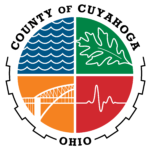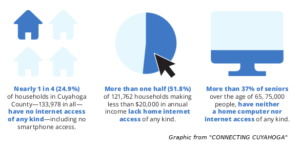 Cuyahoga County, Ohio — which includes the city of Cleveland and many of its suburbs — has just released a new report on the ways digital inclusion could improve the operational efficiency of several of its departments, while making County services more accessible to a large number of citizens.
Cuyahoga County, Ohio — which includes the city of Cleveland and many of its suburbs — has just released a new report on the ways digital inclusion could improve the operational efficiency of several of its departments, while making County services more accessible to a large number of citizens.
“CONNECTING CUYAHOGA: Investment in Digital Inclusion Brings Big Returns for Residents and Administration“ was researched and written by Cleveland-based nonprofit Connected Insights under a contract with the Cuyahoga County Office of Innovation & Performance. NDIA assisted with the project as a subcontractor, as did Drs. Karen Mossberger and Shawn Novak of Arizona State University and Dr. Amy Sheon of the Urban Health Initiative of the Case Western Reserve University School of Medicine. (Connected Insights and the Urban Health Initiative are NDIA affiliates.)
The report begins:
County investments in online platforms and public-facing systems hold great potential for improving County services. Yet such efforts will not yield their expected returns while roughly half of the potential users of these systems live without access to the internet or the skills to use it… The county needs to address these inequities in order to increase regional competitiveness, economic mobility and social returns in addition to operational efficiencies.
 “CONNECTING CUYAHOGA” supports this assertion with an extensive analysis of home Internet connection gaps in communities throughout Cuyahoga County, using Census and other data to show the large numbers of low-income and older citizens — the groups most likely to need to communicate with County agencies — who lack home Internet access. It describes the ways that communities across the country are pursuing digital inclusion strategies, often led by local governments.
“CONNECTING CUYAHOGA” supports this assertion with an extensive analysis of home Internet connection gaps in communities throughout Cuyahoga County, using Census and other data to show the large numbers of low-income and older citizens — the groups most likely to need to communicate with County agencies — who lack home Internet access. It describes the ways that communities across the country are pursuing digital inclusion strategies, often led by local governments.
Subsequent chapters discuss the ways that an aggressive digital inclusion strategy could advance the County’s Strategic Goals and improve “social returns in addition to operational efficiencies” for County departments including Jobs and Family Services (i.e. SNAP, TANF, and Medicaid), Senior and Adult Services, Development, and Child and Family Services as well as the Treasurers’ Office. The report also looks at the potential impact of greater client Internet access and literacy on the County’s workforce and health care programs.
Finally, the report presents specific recommendations for a County-led digital inclusion strategy including:
- The creation of a permanent leadership position within the Office of Innovation and Performance, responsible for policy, program design, and management in the area of digital inclusion.
- A program of competitive grants for community organizations to offer computer instruction and connectivity support.
- An advisory council of community stakeholders to discuss how to continue to support increasing connectivity in the county.
- Improvement of County data collection to enable tracking of programmatic impact and cost-savings from the digital inclusion effort.
- Promotion of interdepartmental efforts to support digital inclusion within existing county programs.
The County press release announcing “CONNECTING CUYAHOGA” says:
A key takeaway from the report is how increases in broadband adoption over time would positively impact the County. An increase in broadband can lead to significant economic growth, enhanced community prosperity and a higher population of residents with full-time employment. Information technology use in communities can be associated with many benefits for governments, including greater access to government information and services, more trust and confidence in government, better health outcomes and increased social connections for isolated seniors.
“The Connecting Cuyahoga report shows us what we really need to know—that nearly one in four households in Cuyahoga County have no internet access of any kind, and more than one half of households making less than $20,000 in annual income lack home internet access,” said Chief Innovation & Performance Officer, Catherine Tkachyk. “This report… solidifies our understanding of the importance of making broadband accessible to all.”
For more information contact Connected Insights Executive Director Samantha Schartman at [email protected].
(This project was partially supported by a grant from the Cleveland Foundation to Cuyahoga County Office of Innovation & Performance.)
